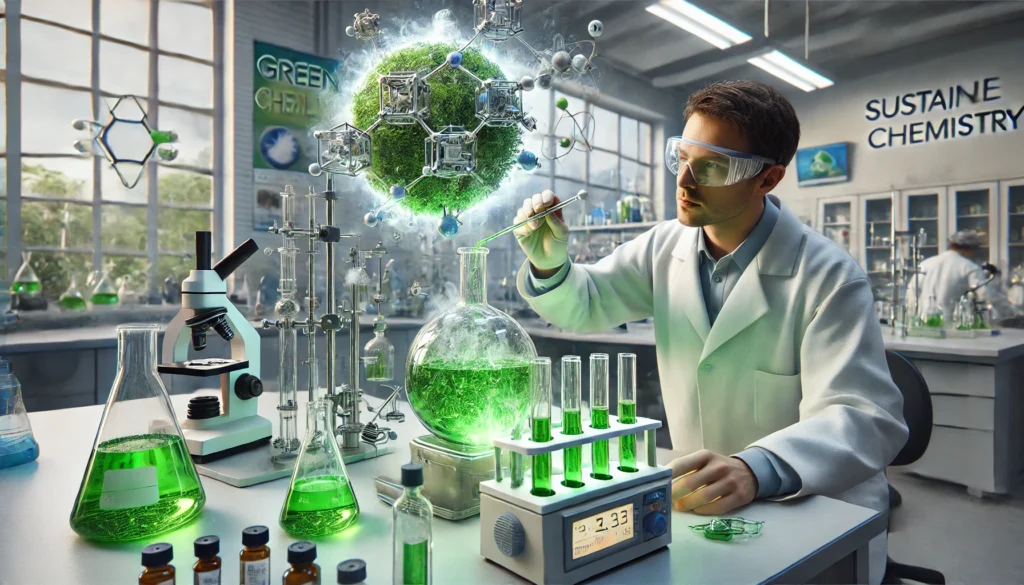In our current world, where environmental issues are becoming more prominent, green chemistry is gaining significant attention. By focusing on developing environmentally safe chemicals, green chemistry aims to reduce pollution and promote sustainability. This blog explores how green chemistry is making a difference, especially in India, and why it’s crucial for our future.
What is Green Chemistry?
Green chemistry, often referred to as sustainable chemistry, focuses on creating chemical products and processes that minimize or eliminate the production of hazardous substances. It utilizes cutting-edge scientific methods to produce chemicals that are safer for both the environment and human health.
Why Green Chemistry Matters
India is a rapidly developing country with a booming industrial sector. However, this growth has led to significant environmental challenges, including pollution and waste. Green chemistry offers solutions to these problems by:
- Reducing harmful emissions
- Minimizing waste production
- Promoting the use of renewable resources
- Enhancing safety for workers and communities

Principles of Green Chemistry
Green chemistry is guided by twelve fundamental principles that focus on sustainability and safety. Here are a few key ones:
Prevent Waste: Design chemical processes to minimize waste production.
Use Safer Chemicals: Choose chemicals that pose little or no harm to humans and the environment.
Energy Efficiency: Develop processes that require less energy, preferably from renewable sources.
Renewable Feedstocks: Use raw materials that are renewable rather than depleting natural resources.
Innovative Green Chemistry Solutions
Biodegradable Plastics
Traditional plastics are a major environmental concern due to their non-biodegradable nature. Companies like Biotec (a company that manufactures biodegradable polymers) are developing biodegradable plastics from natural materials like starch and cellulose. These plastics break down more easily and reduce long-term environmental impact.
Green Solvents
Chemical processes often involve solvents that can be harmful. Green solvents, such as water or bio-based solvents, are safer alternatives. For example, Green Biologics (a company that produces bio-based chemicals) is producing green solvents from renewable resources, reducing the reliance on fossil fuels.
Catalysis
Catalysts are materials that speed up chemical reactions without being consumed in the process. Green chemistry emphasizes using environmentally benign catalysts. Johnson Matthey, a prominent name in sustainable technologies, develops catalysts that facilitate cleaner chemical reactions, thus minimizing waste and conserving energy.
Benefits of Green Chemistry
Green chemistry offers numerous benefits, including:
Environmental Protection: This approach decreases pollution and preserves natural resources.
Economic Savings: Lower waste and energy costs lead to financial savings.
Health Benefits: Safer chemicals mean fewer health risks for workers and consumers.
Regulatory Compliance: Helps industries meet environmental regulations and avoid penalties.
Challenges and Considerations
Despite its many advantages, green chemistry faces challenges:
Cost: Initial investment in green technologies can be high.
Research and Development: Ongoing research is needed to develop new green chemicals and processes.
Education: Educating chemists and industry professionals about green chemistry principles is essential for widespread adoption.
Government and Community Initiatives
The Indian government and various organizations are supporting green chemistry through:
National Green Tribunal (NGT): An organization that handles environmental protection cases.
Green Chemistry Network Centre (GCNC): Promotes green chemistry education and research in India.
Success Stories
Several success stories highlight the impact of green chemistry:
Biocon: An Indian biopharmaceutical company that uses green chemistry principles in drug development, reducing environmental impact.
Atul Ltd.: A chemical manufacturing company in India that implements green chemistry to create safer and more sustainable products.
Future of Green Chemistry in India
The future of green chemistry in India looks promising. With increasing awareness and support from the government and industries, the adoption of sustainable chemical practices is expected to grow. Ongoing innovation and teamwork will be crucial in overcoming obstacles and realizing a more sustainable future.
Conclusion
Green chemistry is a powerful tool in the fight against environmental pollution and climate change. By creating chemicals that are safe for the environment and using sustainable methods, we can safeguard our planet and enhance our quality of life. As we move towards a more sustainable future, embracing green chemistry will be crucial for creating a healthier and cleaner world.
Author’s Note:
Green chemistry not only aids the environment but also paves the way for new opportunities in innovation and growth. Supporting green chemistry efforts allows us to make a positive difference and work towards a sustainable future.
G.C., Ecosociosphere contributor.




